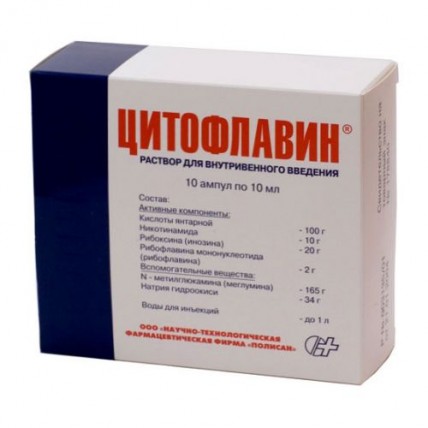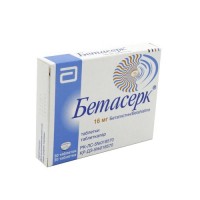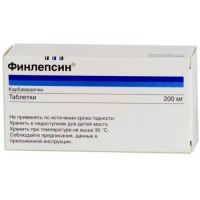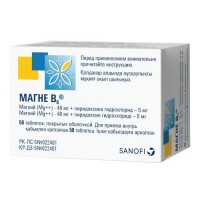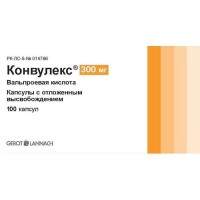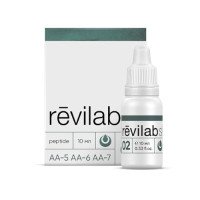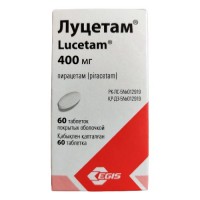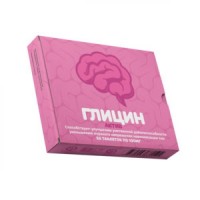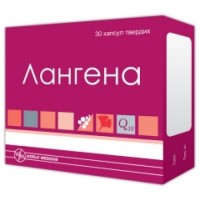The instruction for medical use
of TSITOFLAVIN® medicine
Trade name
ЦИТОФЛАВИН®
the International unlicensed name
Is not present
the Dosage form
Solution for intravenous administration, 10 ml
Structure
of 10 ml of drug contain
active agents: succinic acid of 1.00 g, niacinamide of 0.10 g, inosine (inosine) of 0.20 g, Riboflavinum sodium phosphate (Riboflavinum) of 0.02 g,
excipients: N-metilglyukamin (Megluminum), sodium hydroxide, water for injections.
The description
Transparent liquid of yellow color
Pharmacotherapeutic group
Drugs for treatment of diseases of nervous system others.
The code of automatic telephone exchange N07XX
the Pharmacological
Pharmacokinetics At properties of intravenous infusion with a speed about 2 ml/min. (in terms of undiluted TsITOFLAVIN) succinic acid and inosine are utilized almost instantly and in blood plasma are not defined.
Succinic acid – the peak of concentration decides within the first minute after introduction on further fast decrease without cumulation and return of its level to background values owing to a metabolization to water and carbon dioxide.
Inosine is metabolized in a liver with formation of the inozinmonofosfat with the subsequent its oxidation to uric acid. In insignificant quantity it is removed by kidneys.
Niacinamide is quickly distributed in all fabrics, gets through a placenta and into breast milk, is metabolized in a liver with formation of N-metilnikotinamida, removed by kidneys. Plasma elimination half-life makes about 1.3 hours, the equilibrium volume of distribution – about 60 l, the general clearance – about 0.6 l/min.
Riboflavinum is distributed unevenly: the greatest number in a myocardium, a liver, kidneys. Plasma elimination half-life makes about 2 hours, the equilibrium volume of distribution – about 40 l, the general clearance – about 0.3 l/min. Gets through a placenta and into breast milk. Communication with proteins of plasma – 60%. It is removed by kidneys, partially in the form of a metabolite, in high doses – mainly in not changed look.
A pharmacodynamics
Pharmacological effects are caused by combined effect of the components which are a part of the drug TsITOFLAVIN.
TsITOFLAVIN promotes activization of aerobic metabolism of cells that leads to increase in utilization of glucose, increase in β-oxidation of fatty acids and resynthesis of γ-aminobutyric acid in neurons.
TsITOFLAVIN increases resistance of membranes of nervous and glial cells to influence of ischemia that is expressed in decrease in concentration of the neurospecific proteins characterizing the level of destruction of the main structural components of nervous tissue.
TsITOFLAVIN improves coronary and brain blood-grooves, activates metabolic processes in the central nervous system, restores the broken consciousness, promotes regress of neurologic symptomatology and improvement of cognitive functions of a brain. Possesses the fast awakening action at postanesthetic oppression of consciousness.
At use of the drug TsITOFLAVIN in the first 12 hours from the beginning of development of a stroke a favorable course of ischemic and necrotic processes in a defeat zone (reduction of the center), recovery of the neurologic status and decrease in level of an invalidization in the remote period are observed.
Indications
At adults in complex therapy:
– an acute ischemic disorder of cerebral circulation
– consequences of cerebrovascular diseases (a brain heart attack consequence, cerebral atherosclerosis)
– toxic and hypoxemic encephalopathy in acute and chronic poisonings, endointoxications, postanesthetic oppression of consciousness and also for prevention and treatment of hypoxemic encephalopathy at cardiac operations with use of artificial circulation
At children (including premature, with the term of a gestation of 28-36 weeks) in complex therapy in the neonatality period:
– in cerebral ischemia
the Route of administration and doses
At adults:
TsITOFLAVIN is applied only intravenously by drop infusion in cultivation on 100–200 ml of 5-10% of solution of a dextrose or 0.9% of solution of sodium of chloride.
1. In an acute disorder of cerebral circulation the drug is administered in the earliest terms from the beginning of development of a disease of 10 ml on introduction with an interval of 8-12 hours within 10 days. At a severe form of a course of the disease the single dose is increased to 20 ml.
2. At consequences of cerebrovascular diseases (brain heart attack consequences, cerebral atherosclerosis) the drug is administered of 10 ml on introduction within 10 days once a day.
3. In toxic and hypoxemic encephalopathy the drug is administered of 10 ml on introduction by two times a day with an interval of 8-12 hours within 5 days. At coma – of 20 ml on introduction in cultivation on 200 ml of solution of a dextrose. In a postanesthetic depression – once in the same doses. At cardiac operations with use of artificial circulation enter into therapies of hypoxemic encephalopathy on 20 ml of drug in cultivation on 200 ml 5% of solution of a dextrose in 3 days prior to operation, in day of operation, within 3 days after operation.
At children (including premature) in the neonatality period with cerebral ischemia the daily dose of the drug TsITOFLAVIN makes 2 ml/kg. The calculated daily dose of drug is entered intravenously by drop infusion (slowly) after cultivation into 5% or 10% dextrose solution (in the ratio not less than 1:5). Time of the first introduction – the first 12 hours after the birth, optimum time to start therapy are the first 2 hours of life. It is recommended to enter the prepared solution by means of the infusional pump with a speed from 1 to 4 ml/h, providing uniform intake of drug in a blood stream within a day, depending on the rated daily volume of solutions for basic therapy, a condition of a hemodynamics of the patient and indicators of an acid-base state. The course of treatment averages 5 days.
Side effects
Seldom:
– a lowering of arterial pressure
– increase in arterial blood pressure
– a fever
– tachycardia
– the general weakness
– short-term pains and discomfort in epigastric area and area of a thorax
– breath difficulty
– nausea
– a headache, dizziness
– tingling in a nose
– a dysosmia
– blanching of integuments of various degree of manifestation
– allergic reactions in the form of a skin itching
– a tranzitorny hypoglycemia
– a hyperuricemia
– exacerbation of gout.
Very seldom:
– sharp excitement
– cyanosis
– a hyperthermia
– spotty papulleznaya rash
– a blackout
– cold sweat
– numbness of fingers of hands
– a sharp abdominal pain
– vomiting
- a Quincke's edema
At children (including premature) in the period of a neonatality is possible development of disturbances from acid-base balance (alkalosis).
At fast drop introduction the emergence of the undesirable reactions which are not demanding drug withdrawal is possible:
– hyperaemia of integuments of various degree of manifestation
– feeling of heat
– bitterness and dryness in a mouth
– irritation in a throat.
The contraindication
– individual intolerance of components of drug
– pregnancy
– the breastfeeding period
– the patient who is on artificial ventilation of the lungs is not recommended administration of drug when falling partial pressure of oxygen in arterial blood lower than 60 mm Hg.
With care to use drug in the following diseases: nephrolithiasis, gout, hyperuricemia.
Medicinal interactions
Succinic acid, inosine, niacinamide are compatible to other medicines.
Riboflavinum reduces activity of doxycycline, tetracycline, Oxytetracyclinum, erythromycin and lincomycin, is incompatible with streptomycin.
Chlorpromazinum, Imipraminum, amitriptyline due to blockade of a flavinokinaza break inclusion of Riboflavinum in flavinadeninmononukleotid and flavinadenindinukleotid and increase its removal with urine.
Thyroid hormones accelerate Riboflavinum metabolism.
Reduces and prevents side effects of chloramphenicol (disturbance of a hematopoiesis, an optic neuritis).
Let's combine with the drugs stimulating a hematopoiesis, antigipoksant, anabolic steroids.
To newborn (premature) children to carry out the special instructions Administration of Drug under control of indicators of an acid-base condition of capillary blood at least 2 times a day (both before the beginning, and in the course of therapy). Whenever possible it is necessary to control indicators of a serumal lactate and glucose.
Rate of administering of the solution containing TsITOFLAVIN should be reduced or to temporarily stop infusion at newborn (premature) children:
– being on artificial ventilation of the lungs, at emergence of symptoms of the mixed (respiratory and metabolic) alkalosis threatened with development of disturbances of cerebral circulation
– at the kept spontaneous breath and respiratory support by CPAP method or at the laboratory symptoms of a metabolic alkalosis threatened with emergence or uchashcheny apnoea attacks receiving air-oxygen mix through a mask at emergence.
At patients with diabetes to carry out treatment under control of an indicator of glucose of blood.
Perhaps intensive coloring of urine in yellow color.
The feature of influence of medicine on ability to run the vehicle or potentially dangerous mechanisms
does not affect ability to run the vehicle or potentially dangerous mechanisms.
Overdose
of Data on overdose of drug are absent.
At overdose to carry out symptomatic therapy.
A form of release and packing
On 10 ml in ampoules from brown glass. On 5 ampoules place in unilateral blister strip packaging from a film polyvinylchloride. Blister strip packaging is termoskleivat with a film cover or aluminum foil or left open. 2 blister strip packagings together with the instruction for use in the state and Russian languages place in a pack from cardboard.
Storage conditions
In the place protected from light at a temperature not over 25 ºС.
To store out of children's reach.
2 years
not to use a period of storage after the expiration date specified on packing.
Prescription status
According to the prescription
LLC Scientific and Technological Pharmaceutical Firm POLISANG Producer (LLC NTFF POLISANG).
Russia, 192102, St. Petersburg, Salov St., 72, building 2A, ph./fax: (812) 710-82-25.
Name and country of the owner of the registration certificate
of LLC Scientific and Technological Pharmaceutical Firm POLISANG (LLC NTFF POLISANG), Russia.
The address of the organization accepting in the territory of the Republic of Kazakhstan claims from consumers on quality of products (goods): Republic of Kazakhstan, Almaty, Bogenbay St. of the batyr, 136. Ph.: (7272) 72-57-51. E-mail:
To Develop doctorkvi@gmail.com
of TSITOFLAVIN® medicine
Trade name
ЦИТОФЛАВИН®
the International unlicensed name
Is not present
the Dosage form
Solution for intravenous administration, 10 ml
Structure
of 10 ml of drug contain
active agents: succinic acid of 1.00 g, niacinamide of 0.10 g, inosine (inosine) of 0.20 g, Riboflavinum sodium phosphate (Riboflavinum) of 0.02 g,
excipients: N-metilglyukamin (Megluminum), sodium hydroxide, water for injections.
The description
Transparent liquid of yellow color
Pharmacotherapeutic group
Drugs for treatment of diseases of nervous system others.
The code of automatic telephone exchange N07XX
the Pharmacological
Pharmacokinetics At properties of intravenous infusion with a speed about 2 ml/min. (in terms of undiluted TsITOFLAVIN) succinic acid and inosine are utilized almost instantly and in blood plasma are not defined.
Succinic acid – the peak of concentration decides within the first minute after introduction on further fast decrease without cumulation and return of its level to background values owing to a metabolization to water and carbon dioxide.
Inosine is metabolized in a liver with formation of the inozinmonofosfat with the subsequent its oxidation to uric acid. In insignificant quantity it is removed by kidneys.
Niacinamide is quickly distributed in all fabrics, gets through a placenta and into breast milk, is metabolized in a liver with formation of N-metilnikotinamida, removed by kidneys. Plasma elimination half-life makes about 1.3 hours, the equilibrium volume of distribution – about 60 l, the general clearance – about 0.6 l/min.
Riboflavinum is distributed unevenly: the greatest number in a myocardium, a liver, kidneys. Plasma elimination half-life makes about 2 hours, the equilibrium volume of distribution – about 40 l, the general clearance – about 0.3 l/min. Gets through a placenta and into breast milk. Communication with proteins of plasma – 60%. It is removed by kidneys, partially in the form of a metabolite, in high doses – mainly in not changed look.
A pharmacodynamics
Pharmacological effects are caused by combined effect of the components which are a part of the drug TsITOFLAVIN.
TsITOFLAVIN promotes activization of aerobic metabolism of cells that leads to increase in utilization of glucose, increase in β-oxidation of fatty acids and resynthesis of γ-aminobutyric acid in neurons.
TsITOFLAVIN increases resistance of membranes of nervous and glial cells to influence of ischemia that is expressed in decrease in concentration of the neurospecific proteins characterizing the level of destruction of the main structural components of nervous tissue.
TsITOFLAVIN improves coronary and brain blood-grooves, activates metabolic processes in the central nervous system, restores the broken consciousness, promotes regress of neurologic symptomatology and improvement of cognitive functions of a brain. Possesses the fast awakening action at postanesthetic oppression of consciousness.
At use of the drug TsITOFLAVIN in the first 12 hours from the beginning of development of a stroke a favorable course of ischemic and necrotic processes in a defeat zone (reduction of the center), recovery of the neurologic status and decrease in level of an invalidization in the remote period are observed.
Indications
At adults in complex therapy:
– an acute ischemic disorder of cerebral circulation
– consequences of cerebrovascular diseases (a brain heart attack consequence, cerebral atherosclerosis)
– toxic and hypoxemic encephalopathy in acute and chronic poisonings, endointoxications, postanesthetic oppression of consciousness and also for prevention and treatment of hypoxemic encephalopathy at cardiac operations with use of artificial circulation
At children (including premature, with the term of a gestation of 28-36 weeks) in complex therapy in the neonatality period:
– in cerebral ischemia
the Route of administration and doses
At adults:
TsITOFLAVIN is applied only intravenously by drop infusion in cultivation on 100–200 ml of 5-10% of solution of a dextrose or 0.9% of solution of sodium of chloride.
1. In an acute disorder of cerebral circulation the drug is administered in the earliest terms from the beginning of development of a disease of 10 ml on introduction with an interval of 8-12 hours within 10 days. At a severe form of a course of the disease the single dose is increased to 20 ml.
2. At consequences of cerebrovascular diseases (brain heart attack consequences, cerebral atherosclerosis) the drug is administered of 10 ml on introduction within 10 days once a day.
3. In toxic and hypoxemic encephalopathy the drug is administered of 10 ml on introduction by two times a day with an interval of 8-12 hours within 5 days. At coma – of 20 ml on introduction in cultivation on 200 ml of solution of a dextrose. In a postanesthetic depression – once in the same doses. At cardiac operations with use of artificial circulation enter into therapies of hypoxemic encephalopathy on 20 ml of drug in cultivation on 200 ml 5% of solution of a dextrose in 3 days prior to operation, in day of operation, within 3 days after operation.
At children (including premature) in the neonatality period with cerebral ischemia the daily dose of the drug TsITOFLAVIN makes 2 ml/kg. The calculated daily dose of drug is entered intravenously by drop infusion (slowly) after cultivation into 5% or 10% dextrose solution (in the ratio not less than 1:5). Time of the first introduction – the first 12 hours after the birth, optimum time to start therapy are the first 2 hours of life. It is recommended to enter the prepared solution by means of the infusional pump with a speed from 1 to 4 ml/h, providing uniform intake of drug in a blood stream within a day, depending on the rated daily volume of solutions for basic therapy, a condition of a hemodynamics of the patient and indicators of an acid-base state. The course of treatment averages 5 days.
Side effects
Seldom:
– a lowering of arterial pressure
– increase in arterial blood pressure
– a fever
– tachycardia
– the general weakness
– short-term pains and discomfort in epigastric area and area of a thorax
– breath difficulty
– nausea
– a headache, dizziness
– tingling in a nose
– a dysosmia
– blanching of integuments of various degree of manifestation
– allergic reactions in the form of a skin itching
– a tranzitorny hypoglycemia
– a hyperuricemia
– exacerbation of gout.
Very seldom:
– sharp excitement
– cyanosis
– a hyperthermia
– spotty papulleznaya rash
– a blackout
– cold sweat
– numbness of fingers of hands
– a sharp abdominal pain
– vomiting
- a Quincke's edema
At children (including premature) in the period of a neonatality is possible development of disturbances from acid-base balance (alkalosis).
At fast drop introduction the emergence of the undesirable reactions which are not demanding drug withdrawal is possible:
– hyperaemia of integuments of various degree of manifestation
– feeling of heat
– bitterness and dryness in a mouth
– irritation in a throat.
The contraindication
– individual intolerance of components of drug
– pregnancy
– the breastfeeding period
– the patient who is on artificial ventilation of the lungs is not recommended administration of drug when falling partial pressure of oxygen in arterial blood lower than 60 mm Hg.
With care to use drug in the following diseases: nephrolithiasis, gout, hyperuricemia.
Medicinal interactions
Succinic acid, inosine, niacinamide are compatible to other medicines.
Riboflavinum reduces activity of doxycycline, tetracycline, Oxytetracyclinum, erythromycin and lincomycin, is incompatible with streptomycin.
Chlorpromazinum, Imipraminum, amitriptyline due to blockade of a flavinokinaza break inclusion of Riboflavinum in flavinadeninmononukleotid and flavinadenindinukleotid and increase its removal with urine.
Thyroid hormones accelerate Riboflavinum metabolism.
Reduces and prevents side effects of chloramphenicol (disturbance of a hematopoiesis, an optic neuritis).
Let's combine with the drugs stimulating a hematopoiesis, antigipoksant, anabolic steroids.
To newborn (premature) children to carry out the special instructions Administration of Drug under control of indicators of an acid-base condition of capillary blood at least 2 times a day (both before the beginning, and in the course of therapy). Whenever possible it is necessary to control indicators of a serumal lactate and glucose.
Rate of administering of the solution containing TsITOFLAVIN should be reduced or to temporarily stop infusion at newborn (premature) children:
– being on artificial ventilation of the lungs, at emergence of symptoms of the mixed (respiratory and metabolic) alkalosis threatened with development of disturbances of cerebral circulation
– at the kept spontaneous breath and respiratory support by CPAP method or at the laboratory symptoms of a metabolic alkalosis threatened with emergence or uchashcheny apnoea attacks receiving air-oxygen mix through a mask at emergence.
At patients with diabetes to carry out treatment under control of an indicator of glucose of blood.
Perhaps intensive coloring of urine in yellow color.
The feature of influence of medicine on ability to run the vehicle or potentially dangerous mechanisms
does not affect ability to run the vehicle or potentially dangerous mechanisms.
Overdose
of Data on overdose of drug are absent.
At overdose to carry out symptomatic therapy.
A form of release and packing
On 10 ml in ampoules from brown glass. On 5 ampoules place in unilateral blister strip packaging from a film polyvinylchloride. Blister strip packaging is termoskleivat with a film cover or aluminum foil or left open. 2 blister strip packagings together with the instruction for use in the state and Russian languages place in a pack from cardboard.
Storage conditions
In the place protected from light at a temperature not over 25 ºС.
To store out of children's reach.
2 years
not to use a period of storage after the expiration date specified on packing.
Prescription status
According to the prescription
LLC Scientific and Technological Pharmaceutical Firm POLISANG Producer (LLC NTFF POLISANG).
Russia, 192102, St. Petersburg, Salov St., 72, building 2A, ph./fax: (812) 710-82-25.
Name and country of the owner of the registration certificate
of LLC Scientific and Technological Pharmaceutical Firm POLISANG (LLC NTFF POLISANG), Russia.
The address of the organization accepting in the territory of the Republic of Kazakhstan claims from consumers on quality of products (goods): Republic of Kazakhstan, Almaty, Bogenbay St. of the batyr, 136. Ph.: (7272) 72-57-51. E-mail:
To Develop doctorkvi@gmail.com
